
An article published in the journal “Historical Biology” reports a dating of sediments in three British sites where the oldest millipede fossils were found conducted by researchers from the University of Texas at Austin. The result is that the site on the Scottish island of Kerrera is the oldest, 425 million years old, making Kampecaris obanensis the oldest known millipede. This result is important not only for establishing which millipedes among the various British sites are the oldest but in general for the evolution of arthropod groups which include myriapods, insects, and arachnids, linked to that of plants. Their evolution appears to have been faster than previously thought, arriving at complex ecosystems from simple communities in 40 million years.
A problem in the study of the evolution of insects and their myriapod and arachnid cousins is given by the difficulty in their dating. A millipede which was named Pneumodesmus newmani was discovered in 2004, again in Scotland, and dated 428 million years by testing spores found in sediments from that area. It’s a method that presents a large margin of error, a serious problem in the field of paleontology. However, Stephanie Suarez managed to find tiny zircons in the sediments and develop a technique to separate them. It was a great feat because those minerals trap radioactive elements that can allow more accurate dating using the uranium-lead dating method. The result, reported in an article published in the magazine “PLOS ONE” in June 2017, was that Pneumodesmus newmani was “only” 414 million years old.
Today Stephanie Suarez is a doctorate student at the University of Houston but worked once again with professors Michael Brookfield and Elizabeth Catlos of the Jackson School of the University of Texas at Austin to carry out a new dating, this time on three British sites where various fossils of myriapods were discovered. The zircons of the Scottish site of Kerrera indicate an age of 425 million years, those of the English site of Ludlow indicate an age of 420 million years, and those of the Scottish site of Cowie, where Pneumodesmus newmani was discovered, indicate an age of 414 million years.
These results indicate that the fossils from the Kerrera island site are the oldest. Consequently, the species Kampecaris obanensis (Photo courtesy British Geological Survey. All rights reserved) becomes the oldest known among the myriapods, also with respect to insects and arachnids. The species found in the other two sites examined are still very ancient and show a very rapid diversification from a biological point of view. In fact, in the mid-Devonian period, about 385 million years ago, there are fossils that belong to complex ecosystems with many arthropods linked to many species of plants in forests.
In essence, the possibility of obtaining datings that have a good approximation offers a more precise picture of the evolution of myriapods, linked to that of the plants they lived with. It’s an important group among arthropods, animals that are generally not among people’s favorites but are important in the history of life on Earth.


